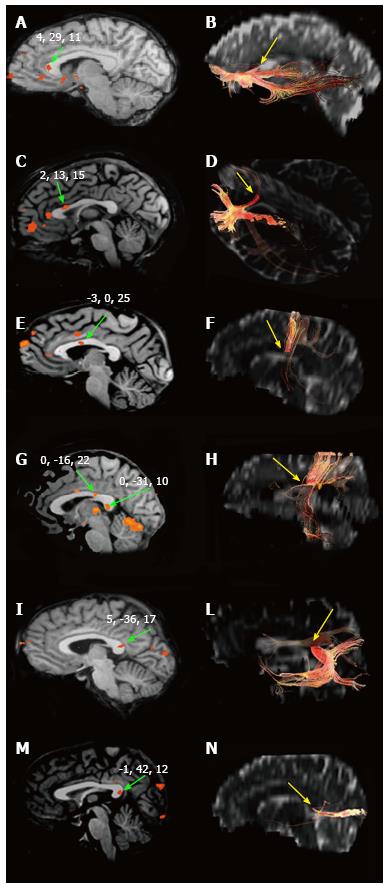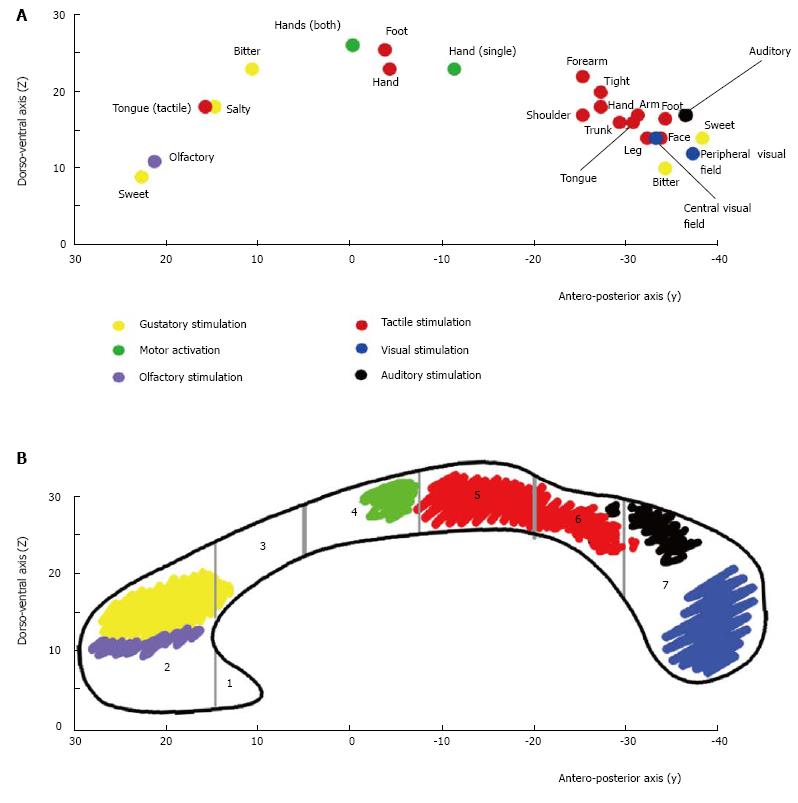Copyright
©2014 Baishideng Publishing Group Inc.
World J Radiol. Dec 28, 2014; 6(12): 895-906
Published online Dec 28, 2014. doi: 10.4329/wjr.v6.i12.895
Published online Dec 28, 2014. doi: 10.4329/wjr.v6.i12.895
Figure 1 Subdivisions of the human corpus callosum.
Midsagittal magnetic resonance image of the corpus callosum (above) and its seven anatomical regions according to Witelson[8]. Region 1: Rostrum; 2: Genu; 3: Anterior midbody; 4: Central midbody; 5: Posterior midbody; 6: Isthmus; 7: Splenium. Both images are oriented in the Talairach space, where the origin of X, Y and Z axes coincides with the anterior commissure (coordinates 0, 0, 0).
Figure 2 Blood-oxygen-level dependent effect within the corpus callosum and interhemispheric fibers.
Blood-oxygen-level dependent effect evoked in the CC by different kind of peripheral sensory stimulation (left) and CC sites where fibers interconnecting the cortical areas activated cross the CC (right). A and B: Focus evoked by olfactory stimulation and callosal fibers connecting primary olfactory cortices, respectively; C and D: The same for gustatory stimuli and areas; E and F: Motor task and motor cortex; G and H: Hand tactile stimulus and somatosensory cortex; I and L: Auditory stimuli and cortex; M and N: Visual stimuli and cortex. Authors’ original data. CC: Corpus callosum.
Figure 3 Callosal activation and callosal fibers topography.
A: Summary diagram showing the distribution of the callosal foci evoked by different stimuli in control subjects. Each dot represents the “mean” value of the y and z Talairach coordinates (reported on the respective Cartesian axes) of the foci evoked by different stimuli. Yellow: Foci by gustatory stimuli; violet: Olfactory stimuli; green: Hand motor tasks; red: Tactile stimuli; black: Auditory stimuli; blue: Visual stimuli. See the text for a detailed description; B: Shows the crossing sites of interhemispheric fibers interconnecting the sensory and motor cortical areas activated by the specific peripheral stimuli. Vertical gray lines mark the seven CC regions according to Witelson[8].
- Citation: Fabri M, Pierpaoli C, Barbaresi P, Polonara G. Functional topography of the corpus callosum investigated by DTI and fMRI. World J Radiol 2014; 6(12): 895-906
- URL: https://www.wjgnet.com/1949-8470/full/v6/i12/895.htm
- DOI: https://dx.doi.org/10.4329/wjr.v6.i12.895











